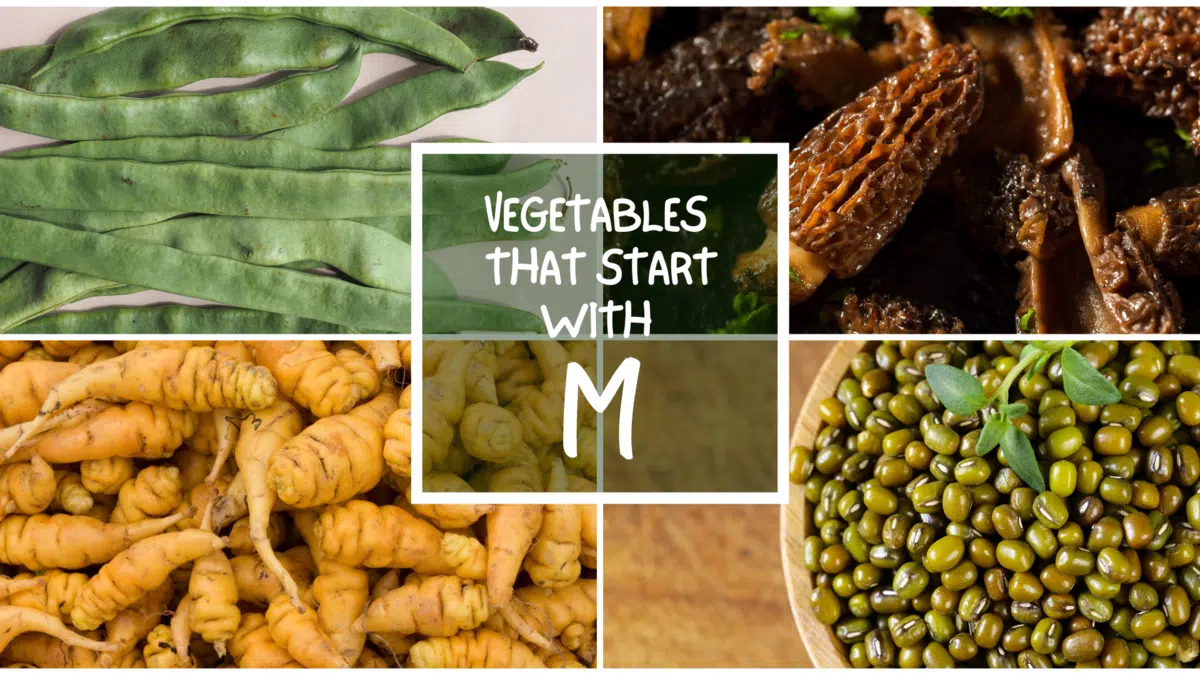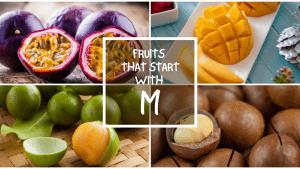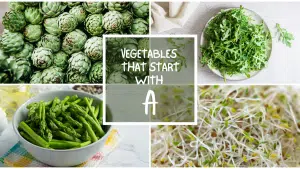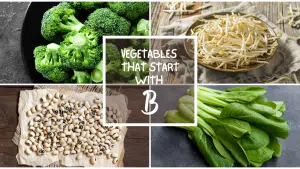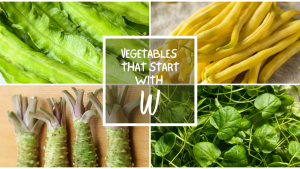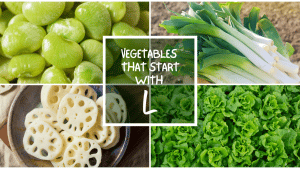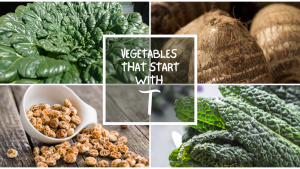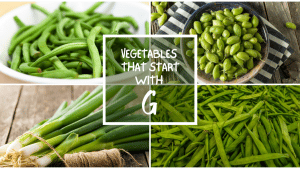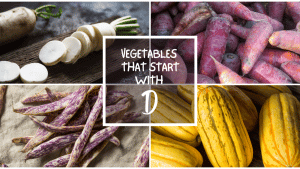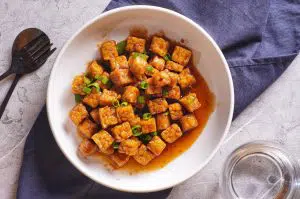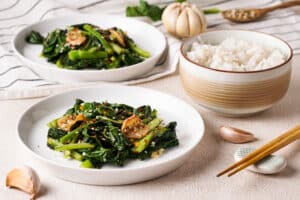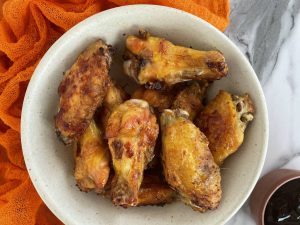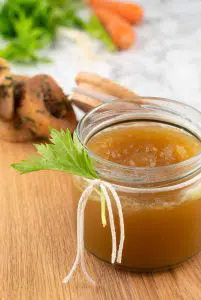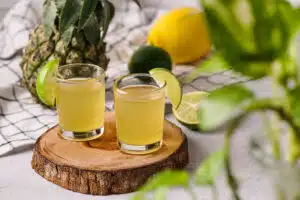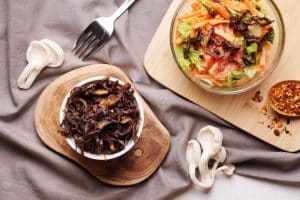All The Vegetables That Start With M
Important Note: When you buy through our links, we may earn a commission. As an Amazon Associate we earn from qualifying purchases. Content, pricing, offers and availability are subject to change at any time - more info.
If your weekly grocery list features the same vegetables week in and week out, it’s time to branch out and try some new produce. Vegetables are integral to a well-rounded diet so branching out with new vegetables diversifies the range of nutrients your body receives. So if you’re looking for new ways to up the nutrient ante, check out some of these delicious M vegetables.
- Maize
- Malabar Spinach
- Malanga
- Mangetout
- Mashua
- Miner’s Lettuce
- Mizuna
- Morels
- Mozuku
- Mung Beans
- Mushrooms
- Mustard Greens
- The Final Letter
Maize
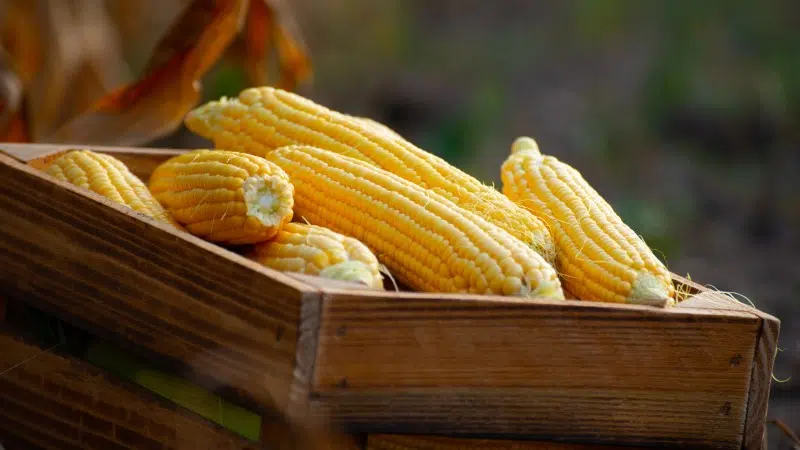
Maize, which is also called corn and Indian corn, is known to the scientific community as Zea mays. Maize is an edible grain that hails from the grass family; it’s indigenous to the Americas where it’s been domestically cultivated for thousands of years. Conveniently, maize can thrive in diverse climates so long as temperatures don’t drop below 19℉. Though maize is produced globally, domestically, most of its production occurs in Illinois, Indiana, Nebraska, and Ohio. Fresh maize can be readily purchased throughout the US during the in-season, summer months.
Maize grows on a single stalk and at harvest comprises gradients of yellow niblets on a cob. Maize is enveloped in an inedible green husk; the cob is also inedible. Of note, maize has a musty, nutty smell and a sweet, buttery flavor. Maize is typically cooked before consumption and it’s a key ingredient in dishes such as mixed vegetables, corn chowder, salsas, and beyond. Another common way to eat maize is simply buttered and salted. Moreover, maize can be ground into meal, starches, and fermented into alcohol.
What’s more, maize has some valuable health benefits. For starters, it’s linked to the prevention of hemorrhoids, preventing anemia, and improved eye health. It’s worth noting that maize is packed with vitamin B, copper, manganese, and other beneficial minerals.
Malabar Spinach
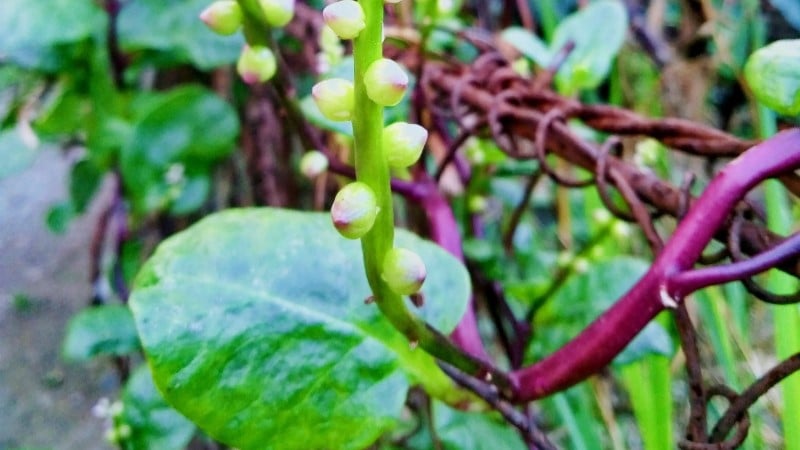
Basella alba, or Malabar spinach as it’s more commonly known, is a green leafy vegetable that’s native to tropical climates. This perennial vegetable is known to grow in parts of Asia such as Sri Lanka, India, and Indonesia. Though it’s not commercially cultivated in the US, home gardeners can easily harvest this spinach variety from seeds or stems; what’s more, Malabar spinach can be grown as an indoor, potted vegetable. Furthermore, although it’s not commercially distributed in the US, you can purchase this vegetable from online produce markets.
Though Malabar spinach looks akin to baby spinach in color and leaf shape, it has purple veins. Malabar spinach can be eaten raw or cooked but when eaten raw the texture has a slight crunch. The taste of Malabar spinach can be compared to arugula as it has lemon and pepper notes. In its raw form, Malabar spinach is typically found in salad mixes, however, when cooked, it’s common to saute, fry, or steam the green leaves. Other common preparations include stirring into soups and as an ingredient in tofu and curry dishes. Malabar spinach is fraught with many valuable nutrients such as calcium, potassium, and iron as well as vitamins A and C.
Malanga

This root vegetable, which is similar to a potato, is known by the scientific name Colocasia esculenta. Indigenous to the tropical climes of South America and Africa, malanga is not commonly found in the US. Closely related to the taro root, malanga also grows in the tropical regions of Cuba, Ecuador, and Nicaragua. Notably, malanga flourishes in temperatures beyond 68℉, and though not commercially cultivated in the US, has been successfully grown in Southern Florida.
Malanga looks like a cross between a yam and a standard white potato; it’s long and thinner like the former and has brown skin and a white starchy interior like the latter. Malanga must be cooked to consume; it can be roasted, steamed, boiled, or mashed. Malanga tastes a bit nuttier than the standard potato though it’s similar in texture. Many malanga dishes are akin to common potato dishes, but they can also be used as a natural thickener in soups and stews. Nutritionally speaking, malanga is rife with fiber and proteins as well as vitamins and minerals, which, taken together, improve gastrointestinal health.
Mangetout

Also known as snow peas, mangetout, which is known by the scientific moniker of Pisum sativum var. Saccharatum, is a pod vegetable that’s edible in its entirety. Other names that mangetout goes by include snow pea and sugar pea. Mangetout is in season in the winter months and is commercially cultivated in many countries with Guatemala as its biggest producer. Though they’re imported to the US and grown by home gardeners, the predominant source of mangetout in the US is the UK.
Mangetout is a thin green pea pod that envelops small flat peas; a fully ripe pod can measure up to three inches or so in length. Notably, mangetout can be enjoyably consumed in its raw, whole form, or cooked. Typical raw preparations include mixed into salads or as a feature in a crudite. Common cooked preparations include steamed or stir-fried. Regardless of its preparation, mangetout tastes very similar to sweet peas. Lastly, mangetout contains high levels of vitamins A and K as well as folate, potassium, and calcium.
Mashua
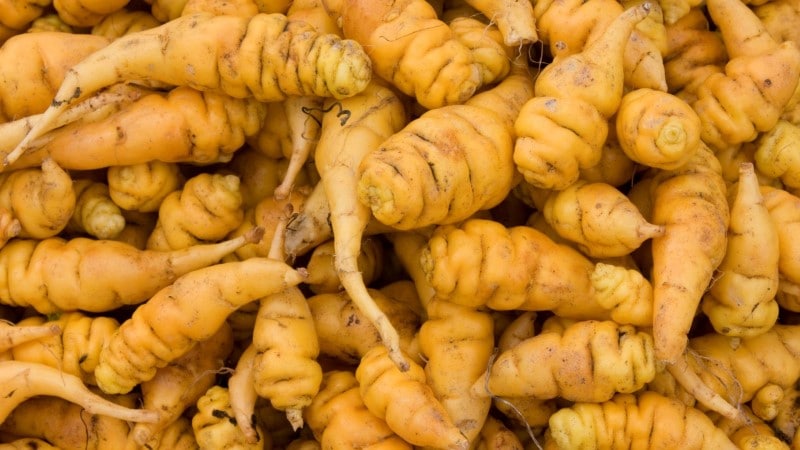
Native to South America’s Andean region, mashua, or Tropaeolum tuberosum as it’s botanically known, is a tuber. Mashua can be found growing in countries such as Peru, Bolivia, and Ecuador, where it is a popular root vegetable. In the US, mashua is successfully harvested in the Pacific Northwest, though it’s not commercially distributed. Of note, mashua is a good vegetable for home gardeners living in temperate climates; it can even be grown as a potted vegetable.
The skin of mashua is akin to potatoes in texture and shape, however, the color is whiter and they are thinner. The crisp, starchy interior is white and crunchy like watercress and it’s common to thinly slice mashua and eat it raw. Other raw preparations include shredded into slaws and pickled. Mashua can also be cooked into mashed or roasted preparations. When eaten raw, mashua tastes similar to radish, but when cooked, it tastes a bit like a turnip. Finally, mashua has great nutritional value; it’s packed with vitamin C, carotene, protein, and amino acids.
Miner’s Lettuce

Native to the western region of the US and parts of Canada, miner’s lettuce, which is scientifically known as Claytonia perfoliata, is a delicious and nutritious green leaf lettuce. Notably, miner’s lettuce naturally grows in Washington, California, Oregon, Utah, and Wyoming among other states. Outside of the US, miner’s lettuce is found in parts of British Columbia and Central America. Miner’s lettuce isn’t typically sold commercially, however, it can be harvested in the wild or grown in home gardens under the right conditions.
Miner’s lettuce has a unique appearance in that the small, bright green leaves look like mini lily pads. Miner’s lettuce is typically used as a salad green; the leaves are delicate and tender while the stems add a lovely crunch to each bite. Miner’s lettuce is mild and a bit earthy. In addition to using this variety as a salad green, miner’s lettuce is also great on sandwiches. Lastly, miner’s lettuce is highly nutritious, containing potent levels of protein, fiber, calcium, and phosphorus.
Mizuna
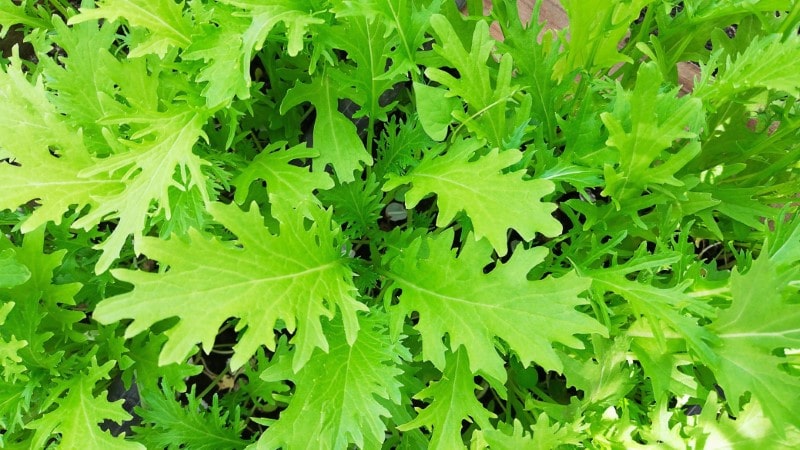
Mizuna, or Brassica rapa var. nipposinica as it’s scientifically known, is a leaf vegetable that hails from East Asia. A close relative to both Brussels sprouts and broccoli, mizuna thrives in the direct sunlight of cool climates. Notably, mizuna has grown in Japan for hundreds of years and astoundingly, was even successfully harvested on the International Space Station. Though mizuna can be grown in home gardens, it’s not commercially cultivated in the US; domestically, it can occasionally be purchased at Asian food markets or local farm stands.
Similar in appearance to flat-leaf parsley, mizuna has small green, jagged leaves and thin stems. Mizuna is eaten raw and is typically mixed into green salads. Similar to arugula, mizuna has a peppery flavor that adds a kick to any salad. Mizuna even makes a great garnish for finished entrees. Although not as common, mizuna is sometimes pickled or sauteed. Best of all, mizuna is highly nutritious, containing calcium, fiber, protein, and vitamins A and C.
Morels
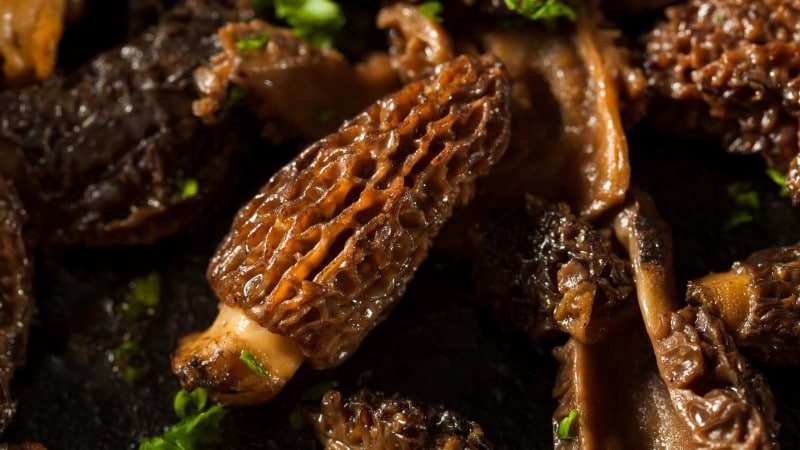
Morels are wild mushrooms, growing at the base of a decaying tree, that can be foraged in the spring months. Known to the scientific community as Morchella esculenta, morels thrive in the temperate climes of North America as well as Turkey, the Himalayas, and Pakistan. Commercially cultivating morels is a very arduous undertaking and though it is done, it’s a very expensive business. Resultantly, procuring morels can be rather costly. Nevertheless, morels are available in the US from grocery stores, online retailers, and farm stands.
Morels are small mushrooms that have an even, white stem with an oblong, jagged cap; the cap, in fact, looks veiny and resembles a honeycomb. Morels are a delicacy and are often cooked with simple ingredients and cooking methods to showcase their natural flavor. Some common morel pairings include beef or egg dishes and even simply atop toast. Lastly, morels are packed with nutritious components such as ascorbic acid, vitamin D, and other noteworthy minerals.
Mozuku
Known by the scientific moniker Cladosiphon okamuranus, mozuku is a variety of seaweed from Okinawa. Commonly used in Japanese cuisine, mozuku is an alga that’s been harvested for more than three decades off the island of Okinawa. Astoundingly, mozuku is exclusively farmed by human hands. Though it’s not commercially cultivated anywhere else in the world, it can be purchased in the US from online retailers.
Notably, mozuku is slippery in texture, roughly the shape of spaghetti noodles, and brownish in color. Mozuku has a light, salty flavor that’s likened to a subtle ocean breeze and it smells like the beach at low tide. In Japanese cuisine, mozuku is typically eaten as a side dish with rice. It’s also prominently featured in salads, soups, and fried dishes. Mozuku contains high levels of Fucoidan which has been linked to cancer treatments and improved immunity.
Mung Beans

Vigna radiata, which is the scientific name for a mung bean, is a legume that’s native to India. Since their ancient cultivation, mung beans have spread to places such as China and regions of Southeast Asia, Africa, and South America. Mung beans are also cultivated domestically, predominantly in Oklahoma. What’s more, mung beans are suitable for growth in a variety of climates so long as they receive up to six hours of direct sunlight each day. Best of all, mung beans can be purchased throughout the US in grocery stores.
Mung beans are similar in size, shape, and color to sweet peas though some are speckled. Of note, mung beans are versatile and tasty; they’re commonly substituted for other beans in recipes such as soups, stews, salads, and curries. These small but mighty beans back a flavorful punch; they’re mildly sweet and slightly nutty in taste. If you can incorporate mung beans into your diet, you’re in for a well-rounded nutrition blast chock full of protein, fiber, minerals, and vitamins.
Mushrooms

Technically a fungus because they’re not grown from seeds nor do they have leaves or roots, mushrooms are treated as a vegetable because they share many of the same nutritional components as veggies. Notably, mushrooms flourish in dark, dank environments and are grown all over the world. Often growing from dead trees, mushrooms were likely first cultivated in Asia. Today, mushrooms grow in many varieties all around the world. Depending on the variety you’re looking for, mushrooms can be found in local grocery stores around the US.
Mushrooms are umbrella-shaped and have a firm stem, and tender cap; the underside of a mushroom cap takes the shape of gills. Mushrooms range in color from white to dark brown and they can vary in size as well. Most varieties of mushrooms can be consumed raw or cooked. Raw mushrooms are a common ingredient in salads while sauteed mushrooms are a delicious accompaniment to steaks or mixed with other vegetables. Popular recipes starring mushrooms include mushroom soup, mushroom risotto, garlic mushrooms, and stuffed mushrooms. Lastly, mushrooms are highly nutritious, containing nutrients such as phosphorus, selenium, copper, potassium, and vitamins B and D.
Mustard Greens
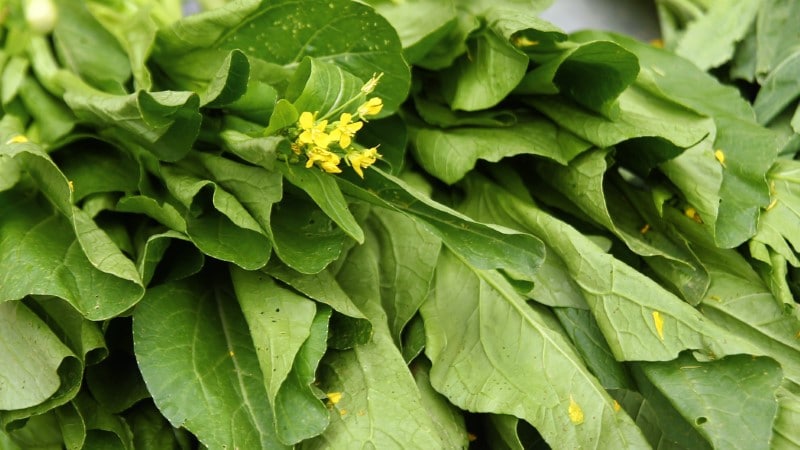
These leafy greens, dubbed the Brassica juncea L. by the science community, are indigenous to India. Today, however, mustard greens are commercially cultivated in parts of China, Japan, Europe, South America, and North America. In the US, mustard green seeds should be sewn in mid-summer for a late-fall harvest. Domestically, these tasty greens are commercially grown in Idaho, Montana, Oregon, Washington, and North Dakota; mustard greens are available year-round in grocery stores.
Ranging in a green gradient of color, mustard greens have large leaves and thick stalks; the leaves are sometimes flat and smooth while others can be crinkly. Like spinach, mustard greens can be enjoyed raw or cooked. Furthermore, they’re peppery and slightly pungent in taste. Mustard greens are delicious chopped into salads, blended into smoothies, sauteed in garlic and oil, and stir-fried. A popular Southern recipe is mustard greens with bacon. An excellent source of fiber, protein, magnesium, and potassium, mustard greens make an excellent addition to your diet.
The Final Letter
Without a doubt, this bunch of M veggies is worth a try. From hearty beans to crunchy greens and seaweed to fungus, this mixed bag of vegetables is delicious and nutritious. Make your meals more interesting and exciting with some of this excellent selection of comestibles.
